Preliminary reports are not encouraging . . .
[Image courtesy of ASIFA—Hollywood Animation Archive]

The first part of Coralie Chappat’s Autobiography Of A Mirror:
Je fouille des yeux la scène initiatique du Grand Véfour dans un respect quasi religieux.
Mon esprit s’isole du monde extérieur, comme par un mouvement de l’âme. Mon corps se sent attiré par un décrochement, l’étrangeté d’un vide dans lequel je me laisse absorber. Lorsque je tente d’en approfondir l’expérience, je perçois un seuil
dont le franchissement provoque une variation du phénomène.
Je flotte telle une passerelle dans l’entre de ces deux espaces.
Get your slice here, courtesy of Bill Bowman and his wife Adrienne Parks, image-makers and wordsmiths in New Orleans, Louisiana.
Bill is one of my oldest friends. I made my first movie with him when we were 12, our own 8mm version of Frankenstein, a masterpiece of cinematic juvenilia. I wrote the script for it. I had never seen a script before and I assumed it must consist of little drawings of each shot with a description of the action and dialogue written next to it. The storyboard was reinvented!
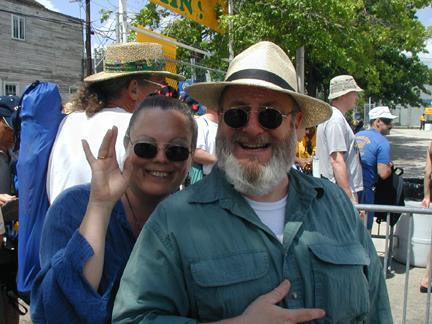
Bill (above, with Adrienne) played Dr. Frankenstein, I assayed the role of the Monster, wearing a papier-mâché headpiece unskillfully joined to my own head with liquid latex. (Liquid latex is cool!) We had read that Jack Pierce spent eight hours applying Karloff's make-up and we felt we could not in good conscience devote less time than that to the process, so we woke up at 2am on the first day of shooting in order to have the make-up perfected by the morning. After half an hour we had done all we could to transform me into the Monster, so we removed the make-up and went back to sleep, reapplying it at first light.
Bill and I have been making movies ever since.
Another epiphany rocks the word, another Christmas season ends. Bob Dylan's Christmas In the Heart reminds us that all is not lost in the art of our time. This year, let's all stand up and change everything, retake our culture from the vile corporations and the sick, demented people who run them.
What good are you anyway if you can't stand up to some old businessman?
— Bob Dylan
[Image by Gentile da Fabriano, just a toiler in the trenches of Renaissance art.]
FRAUD!
SEDUCTION!
RODENT INFESTATION!
The finale of Coralie Chappat’s meal at the Grand Véfour restaurant, Paris:
Poursuivant l’aventure, je suis la saveur qui s’abandonne dans sa générosité enveloppante.
Je suis l’effluve gourmande qui s’envole vers les galeries célestes du
Petit Trianon.
Je suis le claquement du glaçage qui s’affine dans la tiédeur du palais pour n’être plus que filigrane.
Surprise par les textures picturales aristocratiques dont la volupté réside au-delà du savoir, je suis devenue la matière de cette oeuvre d’art.
Mais ce qui se dit dans la délectation et le ravissement, c’est la
pensée alchimique d’un esprit visionnaire. Car le primat de
l’esthétique sur la satisfaction des sens, relève du besoin de l’âme.
Aussi c’est du soin de celle-ci qu’il s’agit.
Dans l’espace de mon être, je suis embellie de cet art singulier.
The Twelve Days of Christmas are rapidly coming to an end — dance, dance while you can!
The meal at the Grand Véfour, Paris, with Coralie Chappat continues:
Sous l’effet de l’enchantement, je détache délicatement la chair et soudainement je suis la texture de la sauce qui l’habille de sa matière.
Lorsque mon regard se déplace, les créations se transforment. J’en admire la suavité des formes.
Je suis la sobriété d’une ligne, la note naturelle, la neutralité qui n’épuise pas le rêve.
Je suis une combinaison d’arômes qui se libèrent, l’éminence d’une matière qui se déplie sans retenue, les parfums d’épices qui dialoguent avec les fragrances enivrantes, les flaveurs aux prises de leur intensité.
. . . from Las Vegas! No taste, no shame, no problem!
Looking for something a little more Baroque?
Father Time Overcome By Love, Hope and Beauty by Simon Vouet.
Same deal, folks.
[With thanks, for the Vouet, to Tristan Forward at The New Emotional Blackmailers Handbook]
. . . salute you! Pluckiness and faithfulness never go out of style!
The stage has been set, the backstage machinery inspected — now the curtain rises on the show, with its sometimes spectacular, sometimes subtle transfer of magic. Coralie Chappat shares a meal with us at the Grand Véfour restaurant in Paris:
Je prends place dans l’écrin au rouge velours du Grand Véfour, dans sa
salle dont je ne puis dire si elle est grande ou petite tellement elle
est magique où s’anime dans une appréciable discrétion, le personnel
que je vois sans voir. Je m’étoffe de l’intimité du lieu. Mes points
de repères s’évanouissent, une sortie du champ a congédié toute
extériorité jusqu’à l’existence même du temps. Je suis portée au gré
d’une sensualité inspirante. J’éprouve vivement la réceptivité de mes
cinq sens, dans une proximité surprenante.
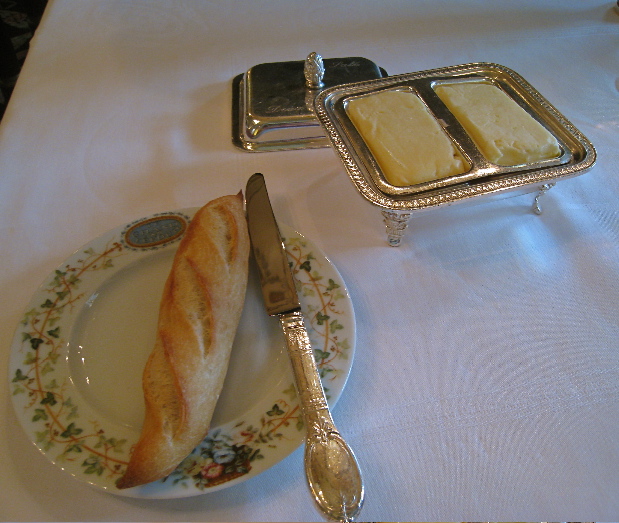
La plus simple des nourritures se revêt de charme élitaire lorsque la
facture des couverts d’argent rencontre la porcelaine délicate.
La sobriété de l’expression est semblable à l’esthétique de la litote
car lorsqu’elle en dit le moins, elle fait entendre le plus. Je suis
plongée dans l’immédiateté du lien qui unit le plaisir au désir.
Les matières se frôlent, se marient, se séparent sans trouble aucun,
tandis que les couleurs se magnifient par leur rapprochement.
[Image by Weegee]
Christmas Day may be over but the Twelve Days Of Christmas continue! We've got a lot more celebrating to do, folks — rest up, grab a nap when and where you can, and get ready for the merriment still to come!
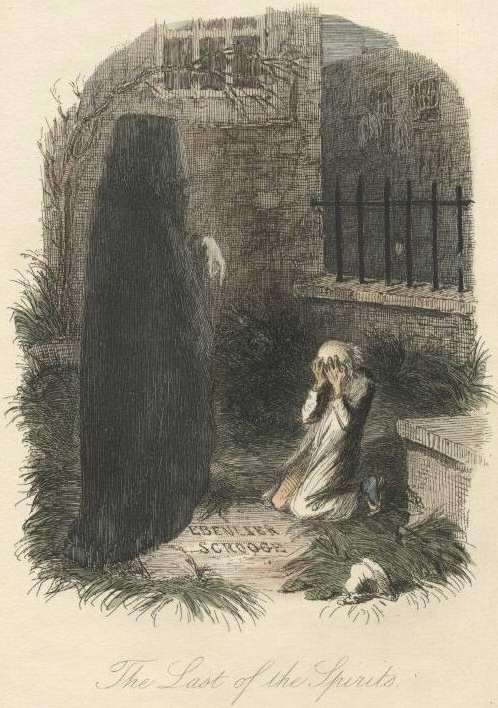
It's been well over a hundred years since Ebenezer Scrooge died. No one who knew him is alive today, of course, but he is remembered — not least from this eulogy spoken at his funeral:
This week, we have lost one of our town's finest citizens. Ebenezer Scrooge passed away five days ago, on Boxing Day, at the age of 82. At his death, he was surrounded by his loving nephew Fred, Fred’s wife, and their three children. His faithful house servant, Mrs. Dilber, who nursed him in the last weeks of his life, described him as peaceful and comfortable, and dressed in his best, surrounded by family, and the beautiful bed curtains that she, and the other house servants, made him.
Many of you will remember Scrooge as a brilliant businessman. His company, Scrooge and Cratchit, gave many jobs in his warehouse to the unemployed throughout the city. He and his business partener Bob Cratchit helped many young men start up their own businesses, too.
Others of you may remember Scrooge for his good works. As the director of many of his charities, such as the Christmas Fund, the Hospital for the Poor, and his Soup Kitchen for the Hungry, I can tell you the good this man has done.
His orphanages have been a refuge for many abandoned children. And his Houses of Learning, which teach my own son and daughters, and which I attended as a young lad, have earned fine reputations.
Some of you may even be old enough to clearly remember Ebenezer Scrooge in the years before his miraculous transformation. Some say he was mean spirited, stingy, and liked it. No one knows exactly what changed him, for he never spoke of it. But many believe that it was the high spirits of Christmas.
For me, I remember Ebenezer in a different way. For he saved me. In a way, we were both crippled when we first met. I physically, and he emotionally and spiritually. If it weren’t for Scrooge, I wouldn’t have met my lovely wife, Edith. If it weren’t for Scrooge, I wouldn’t have had my dear children. If it weren’t for Scrooge, I would have died sick, as a tiny young boy. Because of Scrooge, I haven’t even touched my little crutch in nearly twenty years.
I owe Scrooge my life, and I am forever grateful to him. I think that we can all remember Scrooge not for who he was, but for who he became. And we can all honor his memory, by celebrating his life on Christmas, his favorite holiday. Thank you.
[Transcribed by my niece, Nora Rossi, from an old parish register in London]
One of my favorite things to do in Paris is hunt down the traditional children’s puppet shows put on in parks. Sometimes they are done out of doors with portable stages, but the more venerable ones have little enclosed theaters of their own.
The shows date from the 18th Century, when a French dentist, Laurent Mourget, adapted a character from the Commedia dell’Arte — Polichinelle, called Punch in England — and cast him as the rambunctious star of short puppet shows, which he used to attract clients. (He pulled teeth for free and made his money selling painkillers after the procedure.) Eventually Polichinelle morphed into Guignol, a poor tradesman with great wit and a strong sense of justice, who was constantly getting the better of those he tangled with.
The shows proved more popular than his dental practice, so Laurent devoted himself to them, and they spread to all parts of France. Many of the Guignol companies that survive today can trace their decent back to the dentist and his children, who carried on their father’s work.
Kids still adore them. One of my favorite memories of Paris is a little group of children waiting for an outdoor Guignol performance in a tiny park. They could barely contain their excitement and suddenly began chanting, in high, piping voices, “Le spectacle! Le spectacle!” It’s how we all feel, waiting for a show to start.
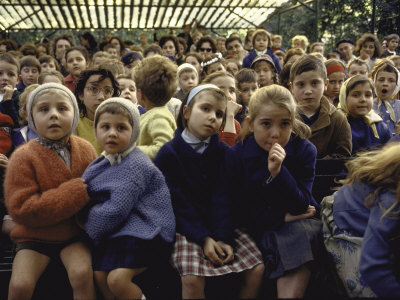
[Photo © Alfred Eisenstadt]
Today, as a special treat for Christmas Eve, Coralie Chappat takes mardecortesbaja readers to a Guignol performance in the Champs de Mars, Paris — revisiting le spectacle for the first time since she was a little girl:
Je n’ai pas revu le petit théâtre de marionnettes depuis mes 6 ou 7 ans. De l’extérieur il me semble intact malgré toutes ces années où je l’ai ignoré. Après avoir passé le guichet de l’entrée, je suis troublée par ce qui se produit en moi. Je ne suis qu’une émotion
d’euphorie ; rien de plus, et rien de moins.
M’asseyant sur un des bancs, face à la scène, je reconnais au sommet du rideau, l’effigie de Guignol, le héros de ma petite enfance. Il n’a pas changé. Moi, non plus. J’ai le sentiment que nous ne nous sommes jamais quittés.
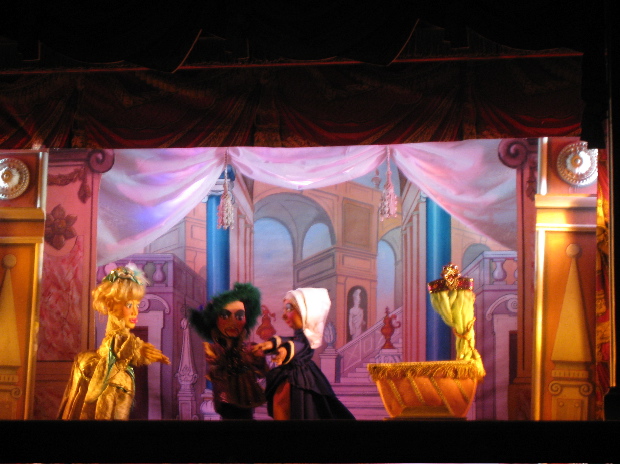
Aujourd’hui se joue “La belle au bois dormant”. Le théâtre a déployé son espace esthétique autonome à la manière d’une petite arche de Noé, embrassant seulement ses passagers. J’attends avec impatience, l’entrée de Guignol sur scène. En choeur nous l’implorons, tandis que le château s’est endormi.
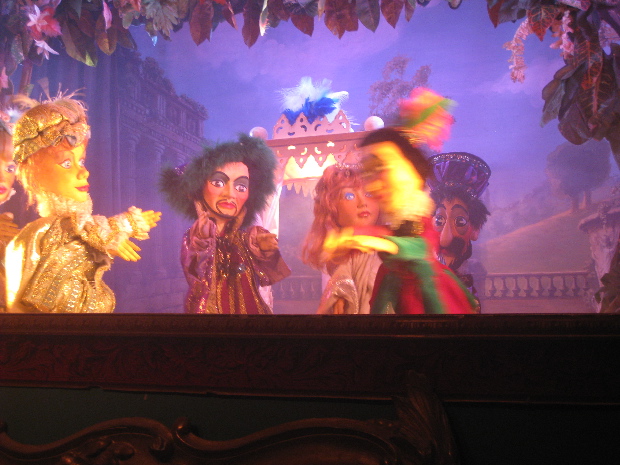
Enfin, Guignol est celui qui conduit le prince au chevet de la Belle. Je suis éblouie par sa présence. Il dégage une noble prestance. Son visage rayonne d’intelligence, de courage et de beauté. Son bel uniforme fait valoir son aristocratie.
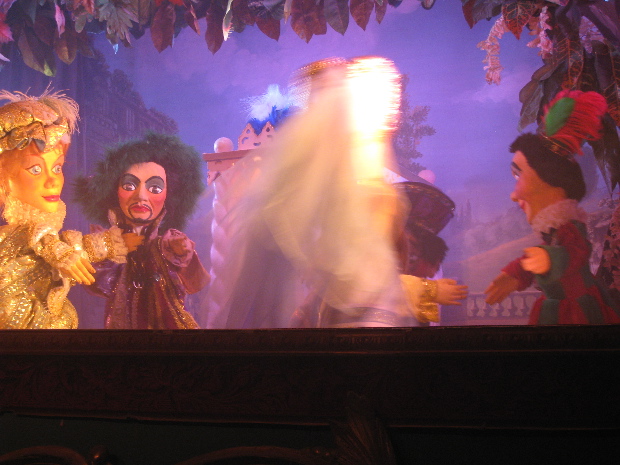
Lorsque le rideau tombe, je reste paisible . . .
Guignol de son immortalité, a fait fi du temps.
[Photos © 2009 Coralie Chappat, except where noted]
Have you ever wondered what Bethlehem looked like at the time Jesus was born
there? It wasn’t something Pieter Bruegel the Elder wondered about —
he knew it looked just like any small town in the Netherlands, where he
lived, and that winter there was pretty much the same as the winters he grew up with.
So in 1566 he painted The Census At Bethlehem,
above, from life, as it were, simply inserting Mary and Joseph and
their donkey into the scene. As you can see, the inn looks pretty
crowded — have Mary and Joseph waited too late to arrange for
accommodation? Mary is about to give birth — suppose Joseph can’t
find her a room?
Well, thereby hangs a tale . . .
Dylan closes his very strange Christmas album with this song about Bethlehem, and closes the song itself with a quiet, heartfelt “Amen”. Bethlehem is no stranger to Dylan than it was to Pieter Bruegel — he sings about it as though it’s as real and familiar as that little whistle-stop up the road, where the only motel in town is tiny and the diner closes at nine.
Why does Dylan feel so at home there, just as much at home as Pieter Breugel once did? It’s a mystery which the art itself has no obligation to resolve.
Much has been made of this exchange from an interview Dylan gave to Bill Flannagan of the Street Newspaper:
BF: You really give a heroic performance of “O’ Little Town Of Bethlehem”. The way you do it reminds me a little of an Irish rebel song. There’s something almost defiant in the way you sing, “The hopes and fears of all the years are met in thee tonight.” I don’t want to put you on the
spot, but you sure deliver that song like a true believer.
BD: Well, I am a true believer.
Dylan watchers will know enough to catch the ambiguity of the response. “A true believer in what?” we might ask. As far as I’m concerned, Dylan’s personal religious beliefs are entirely irrelevant to Christmas In the Heart. Nothing he might say or not say about them can change a note of what’s on the record, and nothing on the record can constitute reliable evidence about what he “really believes” — anymore than Jan Van Eyck’s Altarpiece of Ghent can tell us anything definitive about Jan’s personal religious beliefs.
What we can say is that Dylan sings “O’ Little Town Of Bethlehem” in the voice of a true believer, that the performance is incredibly moving, whether considered as a work of art or as a witness of faith. The way he hits the word “dear” in the phrase “the dear Christ enters in”, the solemn humility and peacefulness of that final “Amen” . . . these are things to marvel at, things that touch the heart.
As with Van Eyck’s altarpiece, Dylan has brought a lifetime of craft to this work, an extraordinary commitment of feeling and care, without a trace of cowardly, modernist irony. It is deeply “religious” art, in subject and execution, art that transcends the personality of the artist . . . the sort of art we don’t see much of these days, and a wonderful reminder of what we’ve been missing.
Art like this doesn’t ask (much less answer) the question “What does the artist really believe?” It asks the question “What do you really believe?”
The sarcastic scorn being heaped upon Christmas In the Heart in some quarters, with knowing, cowardly, modernist irony, tells us all we need to know about the sorry state of our culture in this troubled holiday season of 2009. Dylan’s album tells us that things could be different, should be different.
Can I get an “Amen”?
Back to the Christmas In the Heart track list page.